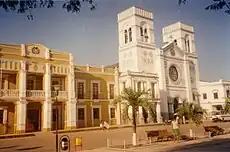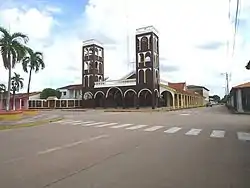Part of a series on |
| Spanish missions in the Americas of the Catholic Church |
|---|
 |
| Missions in North America |
| Missions in South America |
| Related topics |
|
|
The Jesuit Missions of Moxos are located in the Llanos de Moxos of Beni department in eastern Bolivia. Distinguished by a unique fusion of European and Amerindian cultural influences, the missions were founded as reductions or reducciones de indios by Jesuits in the 17th and 18th centuries to convert local tribes to Christianity.
History
Jesuit priests arriving from Santa Cruz de la Sierra began evangelizing native peoples of the region in the 1670s. They set up a series of missions near the Mamoré River for this purpose beginning with Loreto. The principal mission was established at Trinidad in 1686.[1]
List of missions
Meireles (1989) lists the following Jesuit missions of Moxos along with their respective ethnic groups (tribes).[2]: 78–79 Founding dates and a few more additional missions are from Block (1994).[3]: 39
| Mission | Founding date | Location | Group |
|---|---|---|---|
| Loreto | 1682 | Ibare River, left bank | Mojo |
| Trinidad | 1687 | upper Mamoré River, right bank | Mojo |
| San Ignacio | 1689 | Tijamuchi River, right bank | Mojo, Rokorono |
| San Javier | 1691 | Mamoré River | Mojo |
| San Francisco de Borja | 1693 | Rápulo River source | Chimane,[4] Rokorono, Mojo, Movima |
| San Pedro | 1697 | Machupo River source | Canichana |
| San Luis de Gonzaga | 1698 (abandoned 1758) | Rápulo River | Rokorono, Mojo, Movima |
| Santos Reyes | 1710 | upper Beni River | Movima, Maropa |
| Exaltación | 1709 | lower Mamoré River | Cayubaba |
| Concepción de Baures | 1708 | upper Baures River | Baure, Chapacura, Kitemoka, Napeka |
| San Joaquín | 1709 | Baures River | Baure |
| Santa Ana | 1719 | Yacuma River | Movima |
| San Pablo | 1703 (abandoned 1710) | upper Yacuma River | Movima |
| San Simón y Judás | 1744 | San Martín River source | Chapakura, Baure |
| San Nicolás | 1740 | San Martín River | Baure |
| Desposorios de Mojos | 1723 | Yapacaní River (Rio Grande tributary), near right bank | ? |
| Carmen de Mojos | ? | middle Rio Blanco, left bank | Chapakura, Baure |
| San José | 1691 (abandoned 1752) | Apere River, left bank | ? |
| San Martín | 1717 | San Simón River/San Martín River confluence | Bauré |
| Santa Magdalena | 1720 | Machupo River | Itonama |
| San Miguel (1) | 1696 | Baures River | Moré, Baure |
| Santa Rosa (1) | 1705 (abandoned 1740) | upper Mamoré River | |
| Santa Rosa (2) | 1743 (abandoned 1751) | Guaporé River | Moré |
| San Simón | 1746 | Guaporé River | Moré, Aricoroni |
| San Miguel (2) | 1725 (abandoned 1762) | Guapore River | Moré, Aricoroni |
| San Juan Bautista | 1710 (abandoned 1718) | eastern savanna | |
| Patrocinio | 1730 (abandoned 1741) | upper Mamoré River |
Languages
The following indigenous languages, which make up much of the Mamoré-Guaporé linguistic area, were historically spoken in the missions.[2][4]: 11 Moxo was the primary lingua franca (Spanish: lengua general) used in the missions.[4]: 13
- Arawakan languages
- Moxo, spoken by the Mojeños
- Baure, spoken by the Baure people
- Canichana, spoken by the Canichana people
- Movima, spoken by the Movima people
- Cayuvava, spoken by the Cayuvava people
- Itonama, spoken by the Itonama people
- Tsimané, spoken by the Tsimané people
- Mure (extinct)
- Chapacuran languages
- Tacanan languages
- Reyesano (or Maropa)
Gallery
See also
References
- ↑ Gott, Richard (1993). Land without evil: utopian journeys across the South American watershed. London; New York: Verso. p. 225. ISBN 978-0-86091-398-6.
- 1 2 Meireles, Denise Maldi. 1989. Guardiães da fronteira: Rio Guaporé, século XVIII. Petrópolis: Vozes. ISBN 85-326-0017-4.
- ↑ Block, David (1994). Mission culture on the upper Amazon: native tradition, Jesuit enterprise, and secular policy in Moxos, 1660-1880. Lincoln: University of Nebraska Press. ISBN 0-8032-1232-1..
- 1 2 3 Crevels, Mily. 2002. Speakers shift and languages die: An account of language death in Amazonian Bolivia. In Mily Crevels, Simon van de Kerke, Sérgio Meira & Hein van der Voort (eds.), Current Studies on South American Languages [Indigenous Languages of Latin America, 3], p. 9-30. Leiden: Research School of Asian, African, and Amerindian Studies (CNWS).





.jpg.webp)


